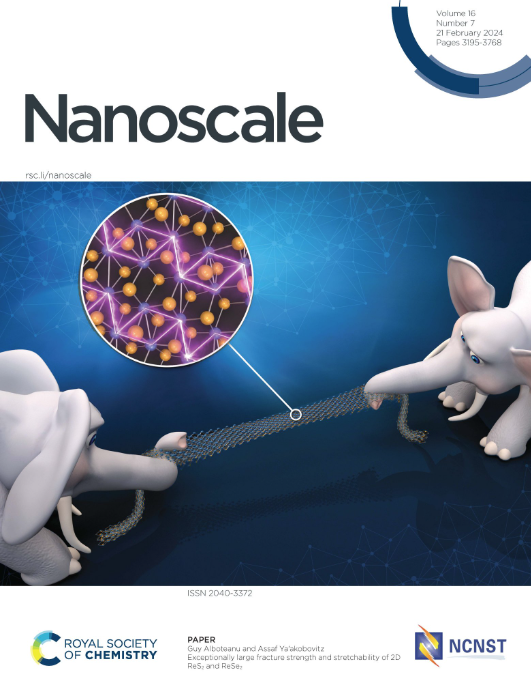超声和超滤联合过程中纤维素纳米晶体取向物理起源的瑞利流现象。
IF 5.8
3区 材料科学
Q1 CHEMISTRY, MULTIDISCIPLINARY
引用次数: 0
摘要
在纤维素纳米晶体(CNC)悬浮液的同时正面过滤和超声处理过程中,首次发现了超声与流体相互作用产生的瑞利声流现象。专门用于原位小角度x射线散射(SAXS)和粒子图像测速(PIV)测量的通道型过滤池与US相结合,可以同时通过顶部的超声振动叶片产生垂直声力,并在底部将cnc集中在跨膜压力下。不同跨膜压力下的SAXS测量表明,cnc的取向随膜表面到振动叶片距离的变化而变化,呈现正交各向异性组织:cnc在振动叶片附近垂直取向,然后在中间各向同性组织,在膜表面附近呈现水平取向。在这项工作中,强调这种正交各向异性组织出现在跨膜压力约0.6 × 10 5 Pa的阈值之上。同时,原位微piv测量显示,在相同的跨膜压力阈值和相同的US条件下,cnc悬浮液中形成了瑞利声流,突出了正交各向异性组织的起源。有人提出,这个阈值允许在膜表面附近有足够的cnc积累,从而实现受限流动,从而产生声流。这项工作强调了声流和CNC颗粒方向之间的相互作用,促进了对微流体应用中液晶样悬浮液操作的理解。本文章由计算机程序翻译,如有差异,请以英文原文为准。
Rayleigh streaming phenomena at the physical origin of cellulose nanocrystals orientations during combined ultrasound and ultrafiltration processes.
Rayleigh acoustic streaming, a phenomenon resulting from the interaction of ultrasound (US) with a fluid, was revealed for the first time during simultaneous frontal filtration and ultrasound process on a cellulose nanocrystal (CNC) suspension. Dedicated to in situ Small-Angle X-ray Scattering (SAXS) and Particle Image Velocimetry (PIV) measurements, channel-type filtration cells coupled with US have been developed to simultaneously generate a vertical acoustic force via an ultrasonic vibrating blade at the top and to concentrate the CNCs under a transmembrane pressure force at the bottom. SAXS measurements under different transmembrane pressure demonstrated a change in CNCs orientation as a function of the distance from the membrane surface to the vibrating blade, with the appearance of an orthotropic organization: CNCs are vertically oriented near the vibrating blade, then have an isotropic organization in the middle and exhibited horizontal orientations near the membrane surface. In this work it has been emphasis that this orthotropic organization appear above a threshold in transmembrane pressure of about 0.6 × 10⁵ Pa. Concurrently, in situ micro-PIV measurements revealed the formation of Rayleigh acoustic streaming in CNCs suspension, for the same threshold in transmembrane pressure and same US conditions, highlighting the origin of the orthotropic organization. It has been proposed that this threshold allows for sufficient accumulation of CNCs near the membrane surface, thus enabling confined flow, to generate the acoustic streaming. This work highlights the interplay between acoustic streaming and CNC particle orientations, advancing understanding of liquid crystal-like suspensions manipulation in microfluidic applications.
求助全文
通过发布文献求助,成功后即可免费获取论文全文。
去求助
来源期刊

Nanoscale
CHEMISTRY, MULTIDISCIPLINARY-NANOSCIENCE & NANOTECHNOLOGY
CiteScore
12.10
自引率
3.00%
发文量
1628
审稿时长
1.6 months
期刊介绍:
Nanoscale is a high-impact international journal, publishing high-quality research across nanoscience and nanotechnology. Nanoscale publishes a full mix of research articles on experimental and theoretical work, including reviews, communications, and full papers.Highly interdisciplinary, this journal appeals to scientists, researchers and professionals interested in nanoscience and nanotechnology, quantum materials and quantum technology, including the areas of physics, chemistry, biology, medicine, materials, energy/environment, information technology, detection science, healthcare and drug discovery, and electronics.
 求助内容:
求助内容: 应助结果提醒方式:
应助结果提醒方式:


